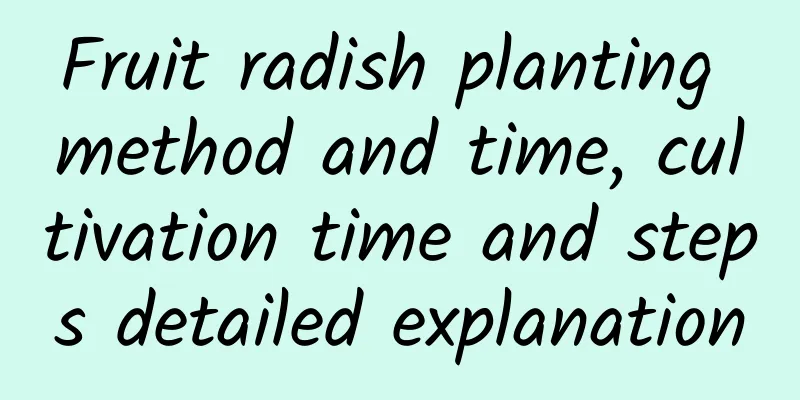Fruit radish planting method and time, cultivation time and steps detailed explanation

The best time to plant fruit radishFruit radish prefers a warm growing environment and is suitable for sowing in spring and autumn, usually around February to March in spring, or August to October in autumn. If cultivated in a greenhouse, the time limit can be relaxed. Fruit radish planting methods and key points1. Select the plot Fruit radishes like light and are not tolerant to waterlogging. Therefore, when planting them, you must choose a plot with sufficient light and convenient drainage. Before sowing, you must turn the soil in advance to ensure that the soil is loose and breathable. Also pay attention to the pH value of the soil. It is best to have neutral or slightly acidic soil. 2. Sowing method The sowing method for fruit radish is hole sowing. Dig small holes at intervals of 20-25 cm, put 2-3 seeds in each hole, then cover with a small amount of soil and wait for the seeds to germinate. Water the newly planted seeds immediately and make sure they are watered thoroughly, so that the seeds will germinate quickly. 3. Thinning and finalizing seedlings When the fruit pineapple seedlings grow 5-6 true leaves, they can be transplanted. Some of the slow-growing and underdeveloped seedlings should be removed, and only one healthy seedling should be kept in each hole. Key points for managing fruit radish1. Add water and apply fertilizer Fruit radish seedlings consume a lot of water and fertilizer during their growth period. In order to promote vigorous growth, they need to be watered every 3-5 days and topdressed with nitrogen fertilizer or organic fertilizer. In the middle and late stages of growth, appropriate topdressing of phosphorus fertilizer and potassium fertilizer should be applied. This will help the roots absorb nutrients and accelerate expansion and fruiting. 2. Field management When the fruit radish seedlings emerge, if the soil is found to be lumpy, it is necessary to weed and loosen the soil in time to make the soil loose. This can also reduce the occurrence of diseases. If diseases are found on the plants, the diseased plants can be pulled out to prevent the spread of the bacteria to other plants. |
<<: Which month is the best for planting broccoli and when is the best time for raising seedlings?
>>: Peony likes the sun or the shade. Do you like the sun or the shade?
Recommend
Plum growing environment conditions and characteristics
Plum growing environment conditions and requireme...
When to transplant hydrangeas
Hydrangea is a flower plant that is very worth gr...
The main value of African hibiscus
All those values Ornamental value To understand t...
How to grow jasmine well
1. Suitable soil If you want to grow jasmine well...
The efficacy and function of mountain peach blossom
1. Anti-inflammatory Mountain peach blossom has a...
How to mix granular soil? The best formula for mixing granular soil into nutrient soil
Granular soil preparation requirements With the r...
How many years does the plum tree bear fruit?
Plum trees bear fruit after several years of plan...
Can the fortune tree be watered with beer?
Can the fortune tree be watered with beer? Beer c...
How to fertilize the money tree
1. Fertilization method Generally speaking, ferti...
Cultivation methods and precautions of Mongolian yew
Before germination Because their seeds are very s...
Does the bottle orchid prefer shade or sun?
Does the bottle orchid prefer shade or sun? Bottl...
How to water flowers with rusty water
Is it possible to water the flowers? Iron is an e...
How to sterilize black orchid
1. Root sterilization Before planting the newly b...
How to grow Shizhixue quickly?
1. How to raise 1. Loam: Loam with loose texture,...
The difference between woodruff and rose
1. Basic characteristics 1. Woodruff flower. The ...









